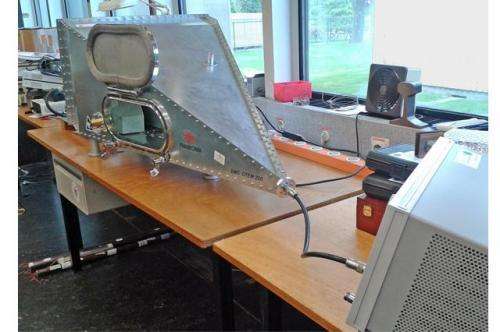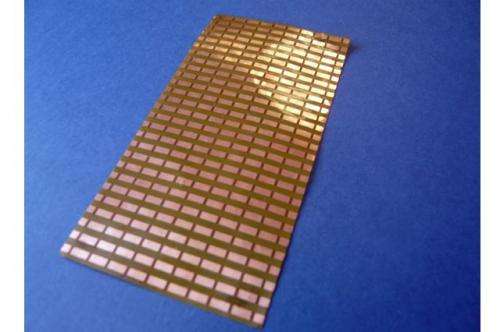Smaller artificial magnetic conductors allow for more compact antenna hardware

Much smaller artificial magnetic conductors (AMCs) that can allow for more compact antenna hardware have been created by a team of researchers in the Netherlands and Spain. They have also developed a system to evaluate AMC miniaturisation approaches.
Imitating perfection
Artificial magnetic conductors are effectively homogeneous metamaterial structures that behave as perfect magnetic conductors in a limited range of frequencies. Magnetic conductors provide an in-phase reflection of incident electric fields, which means they can be used to enhance the performance of antennas.
Proposed applications for AMCs include improving antenna radiating efficiency, reduction of main-to-side lobe ratio, and suppression of surface waves in printed antennas. Importantly, their ability to affect antenna performance can also enable the use of more compact antenna configurations, which is a constant priority in antenna applications such as mobile phones.
Practical AMCs consist of a repeating pattern of resonant cell structures (unit cells). To use AMCs as antenna reflectors or ground planes the AMC has to act as a homogenous plane for the antenna at the antenna's operating frequency. This allows the in-phase reflection response and avoids any unwanted interactions with single resonator cells in the AMC structure.

As a result, there is a trade-off between the AMC unit cell size and how close the antenna can be to the AMC surface without losing the benefits of using it. This minimum required separation is particularly important for compact antenna applications.
Bucking a trend
The first – mushroom shaped – AMC design was presented in 1999, and since then, lots of strategies have been proposed to reduce the size of the unit cell. In this issue of Electronics Letters, a team of researchers from Eindhoven University of Technology and Universitat Autònoma de Barcelona report their efforts to bring together lessons from these strategies to develop even smaller AMC and antenna designs.
"We present a comprehensive analysis of all the parameters involved in miniaturisation strategies, identifying the existing trade-offs. Taking these into account, we present a fair comparison methodology and then present a miniaturised planar design achieving a 40% reduction of the largest dimension compared to an equivalent AMC design using the same substrate," said team member Mercè Grau Novellas.
By attempting to take into account all the parameters that have an impact on the final size of a resonant structure cell, and understanding all the present trade-offs, the team has come up with a design that is simple and easy to fabricate. "Some of the strategies that have been studied propose complex designs, focusing on the reduction of the footprint area. However, the influence of the thickness is seldom mentioned. This parameter is the main contribution to the inductive behaviour in the parallel LC simplified equivalent model of a resonant unit cell," explained Grau Novellas.
Efficient integration
Their proposed smaller resonator unit cell design will allow antennas to be placed closer to the AMC surface to obtain better performance in terms of efficiency, bandwidth and directivity in low-profile applications, which are, in turn, easier to integrate with other systems. The team also believe this work will aid in future research, as the comparison methodology proposed as part of the work can be used to compare future designs and to evaluate the effectiveness of future miniaturisation strategies.
For the team, the design and realisation of AMCs is part of their wider research interests in new materials, devices and radiating systems for miniaturisation, and performance enhancement of radiofrequency front-ends.
"The development of compact antennas with high performance has a significant impact on the ease of integration with larger systems. The use of miniaturised AMCs not only facilitates integration in terms of size, but also compatibility with the surrounding elements. The presence of a ground plane reduces the radiating efficiency of printed antennas, and the use of magnetic conductors overcomes this issue. This efficiency improvement impacts on the overall system power consumption. It has been proven that the use of these types of structures have several benefits and so we think that their use will become more and more common in the following years," said Grau Novellas.
More information: "Miniaturisation of artificial magnetic conductors: comparison methodology and realisation of compact unit cell" M. Grau; R. Serra; J. Parrón. Electronics Letters, Volume 50, Issue 19, 11 September 2014, p. 1340 – 1342. DOI: 10.1049/el.2014.2538
Journal information: Electronics Letters
Provided by Institution of Engineering and Technology
This story is published courtesy of Electronics Letters. For additional Electronics Letters news and features visit theiet.org/eletters.



















